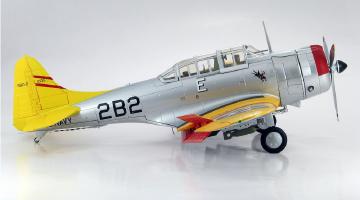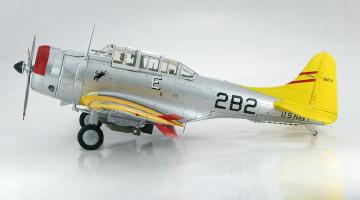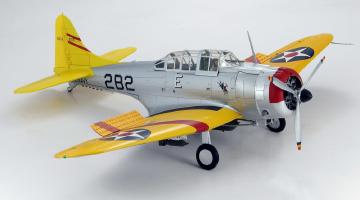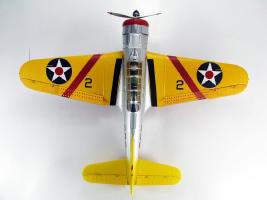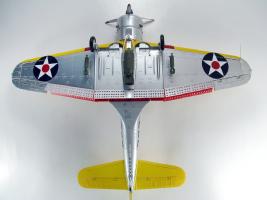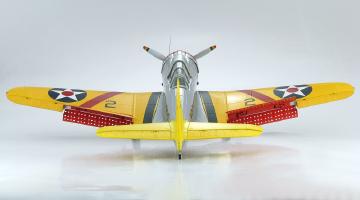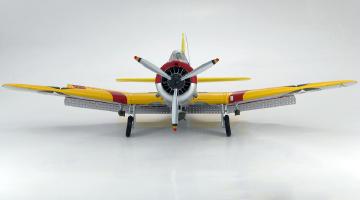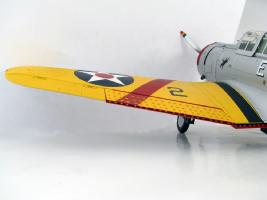Hobby Master Archive
Air Power Propellers 1/32
SBD
Douglas Dauntless SBD-2 2-B-2, VB-2 USS Lexington CV-2, early 1941
Hobby Master 1/32 PREMIUM COLLECTION Air Power Series HA0201 Douglas SBD 2, 2-B-2 VB-2 USS Lexington, CV-2, early 941
Premium Collection 1/32 Scale airplanes Limited Edition only 900 world-wide Features Movable rear gun Working dive brakes, rudder & ailerons Engine cowling can be removed Rotating metal propeller Sliding canopy Retractable undercarriage Rolling wheels Movable centerline bomb rack Bombs under each wing Realistic looking crew L - 12.4 in (315mm) W - 15.75 in (400mm) H - 4.8 in (122mm) Weight - 1.98 lb (900g)
The US Military initially ordered 144 Douglas Dauntless SBD-1s with only 57 actually SBD-2. The remaining 87 aircraft from the initial contract were completed but were configured as SBD-2s. Designed as a light bomber and reconnaissance aircraft, various versions of the Dauntless served during the war with the US Marine Corps, Army and Navy. The Douglas Dauntless was the workhorse of the US Navy in the Pacific. The Dauntless dive- bomber was the only plane to fight in every major Pacific engagement and because of the battles and the courage of the men that flew them, this plane became one of the most successful designs of WWII. Production of the Dauntless ended in July 1944, by which time a total of 5,936 had been built in all versions.
SBD-2 BuNo. 2106 was initially assigned to VB-2 (Bombing Squadron Two) aboard the USS Lexington and wore the side code 2-B-2. 2106 arrived in late December 1940 or early January 1941 and became the favorite aircraft for CAPT Mark T. Whittier USN. On December 5, 1941 the aircraft was left in Hawaii for repairs and survived the Japanese attack on the 7th. March 10,1942 Lt. (JG) Whittier and radioman-gunner Stanley flew 2106 on a raid at Lae-Salamaua New Guinea and were awarded the Navy Cross for their actions. Once again luck would be with 2106 as it and 4 other SBDs from USS Lexington were left at Pearl Harbor in April 1942 for re-assignment. The USS Lexington was lost at the Battle of the Coral Sea. The plane was transported to Midway and assigned to VMSB-241 (USMC Scout Bombing Squadron Two Forty One). On June 4, 1942, repainted and wearing “White 6” the aircraft was manned by 1st Lt. Iverson Jr. and radioman- gunner PFC Reid. They were one of many SBDs to participate in the decisive Battle of Midway and one of the few Dauntless to survive the attack on the Japanese carrier Hiryu. Half of the VMSB-241 Dauntless’ were lost during this attack and both Iverson and Reid were wounded. It is estimated that there were between 210 and 260 holes in their airframe but some how managed to crash land on Midway and survive. Iverson was awarded the Navy Cross and Reid the DFC for their heroism during the mission. With so much damage 2106 was sent for a complete overhaul and reassigned to the Carrier Qualification Training Unit (CQTU) at NAS Glenview, Illinois. On June 11, 1943 during a routine carrier qualification flight the aircraft stalled and plunged into Lake Michigan. For 50 years 2106 rested 170 feet down in cold freshwater until October 1993 when it was discovered and recovered in January 1994. After conducting historical document research by the teams at the National Museum Of Naval Aviation, the Naval Historical Center, and the Institute of Nautical Archaeology they realized that not only did they have a rare aircraft type but also it was one of only 4 to be present at the attack on Pearl Harbor. Most importantly, BuNo. 2106 is the only surviving naval aircraft to have played a significant role at the Battle of Midway. This survivor of one of the most important turning points in the history of the US Navy and indeed the history of the United States can be seen at the National Museum of Naval Aviation located in Pensacola, Florida.
Specifications for Douglas SBD-2 Dauntless Crew: 2 X a pilot and a radioman-gunner SDB-2 had increased fuel capacity but reduced again once self-sealing fuel tanks were available, along with different armament from the SBD-1 2 forward firing 0.50 caliber machine guns. Tail gunner equipped with twin 0.30 caliber machine guns. Capable of carrying a 1600 lb bomb under the fuselage, a crutch was used to swing it clear of the propeller in a dive. Capable of carrying a 650 lb bomb under each wing.
Number of SBD-2s produced: 87 Dimensions Length: 32’ 1" (9.7m) Height: 13’ 7" (4.1m) Wingspan: 41’ 6" (12.6m) Wing area: 325 sq. ft (30.0 sq. m)
Weights Empty weight: 5,652 lb. (2,564 kg) Gross weight: 10,337 lb. (4,698 kg) Maximum weight: 10,360 lb. (4,699 kg)
Engine: 1 X Wright R-1820-32 Horsepower: 1,000 Performance Range: 1,225 miles (1,970 km) Cruise speed: 148 mph (238 km/h) (128 kt) Max speed: 256 mph (412 km/h) (222 kt) Climb rate: 1.080 ft/min. (329 m/min.) Ceiling: 27,260 ft (8,319 m)
THESE PICTURES ARE PRE-PRODUCTION PICTURES TAKEN EARLY IN THE MODEL’S DEVELOPMENT.
| Added to archive | 2018-10-11 |
| Last modified | 2018-10-11 |
